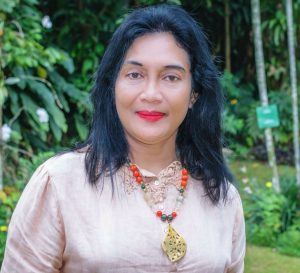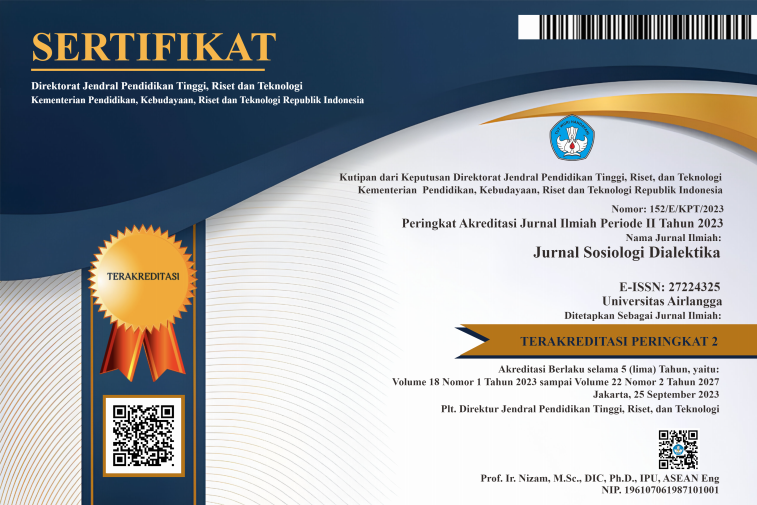Hashtag for humanity: Analyzing #alleyesonrafah movement on social media
Downloads
The humanitarian conflict between Israel and Palestine has spread not only to the real world but also to the virtual world. This research analyzes the #alleyesonrafah movement on social media as a form of global awareness campaign regarding the situation in Rafah, an area in Palestine that is the last line of protection for residents. Through a digital ethnography based on a content analysis approach, this research explores how hashtag is used by social media users to disseminate information, build transnational solidarity, and mobilize support. Data is collected from platforms such as Twitter, Instagram, and Facebook, with a focus on the frequency of use of hashtags, types of content shared, and interaction patterns among users. The research results show that the #alleyesonrafah movement has successfully attracted global attention, especially through humanitarian narratives spread by activists, non-governmental organizations, and the general public. This study also reveals the important role of social media as a medium for minority voices and driving social change. The #alleyesonrafah movement has demonstrated the profound power of social media as a tool for raising global awareness and fostering transnational solidarity in the face of humanitarian crises. However, this is only the beginning of understanding the complex interplay between digital activism and real-world impact. To build on this foundation, future research should adopt a multi-dimensional approach that explores not only the immediate effects of hashtag-driven campaigns but also their long-term implications, ethical considerations, and broader societal influences.
Achmad ZA & Ida R (2018) Etnografi virtual sebagai teknik pengumpulan data dan metode penelitian. The Journal of Society and Media 2 (2):130-145. https://doi.org/10.26740/jsm.v2n2.p130-145.
Anjani S & Irwansyah I (2020) The role of influencers in communicating messages on Instagram social media. Polyglot: A Scientific Journal 16 (2):203-229. https://doi.org/10.19166/pji.v16i2.1929.
Athira B & Balyan N (2023) “#HANDSOFFMYHIJAB”: A digital ethnography of Indian hijab stores’ Instagram pages. Girlhood Studies 16 (3):69-86. https://doi.org/10.3167/ghs.2023.160307.
Ayoub HH, Chemaitelly H, & Abu-Raddad LJ (2024) Comparative analysis and evolution of civilian versus combatant mortality ratios in Israel-Gaza conflicts, 2008–2023. Frontiers in Public Health 12: 1359189. https://doi.org/10.3389/fpubh.2024.1359189.
Azhar R, Rifmayanti C, Harahap AR, Ikhsan M, & Akbar RA (2024) War in #alleyesonrafah meme: Unraveling the Implications of the Palestine-Israel Conflict on Young-Children. IAS Journal of Localities 2 (1):19-32. https://doi.org/10.62033/iasjol.v2i1.45.
BBC News Indonesia (2024) All Eyes on Rafah: Behind the post shared by more than 47 million people on Instagram. BBC News Indonesia, 31 May. [Accessed 13 December 2024]. https://www.bbc.com/indonesia/articles/c511kk2r1x0o.
Berger J & Milkman KL (2013) Emotion and virality: What makes online content go viral? NIM Marketing Intelligence Review 5 (1):18.
Bok K, Song J, Lim J, & Yoo J (2022) Personalized search using user preferences on social media. Electronics 11 (19):3049. https://doi.org/10.3390/electronics11193049.
Cahyani DR (2024) The hashtag “All Eyes on Rafah” is busy on social media, this is the beginning and the meaning. Time, 29 May. [Accessed 22 March 2025]. https://dunia.tempo.co/read/1873560/ramai-tagar-all-eyes-on-rafah-di-media-sosial-ini-awal-mula-hingga-artinya.
Entman RM (1993) Framing: Toward clarification of a fractured paradigm. Journal of Communication 43 (4):51-58. https://doi.org/10.1111/j.1460-2466.1993.tb01304.x.
Fuhrmann L-D & Pfeifer S (2020) Challenges in digital ethnography: Research ethics relating to the securitisation of Islam. Journal of Muslims in Europe 9 (2):175-195.
Hardman N (2024) Hopeless, starving, and besieged. Human Rights Watch, 14 November. [Accessed 22 March 2025]. https://www.hrw.org/report/2024/11/14/hopeless-starving-and-besieged/israelsforced-displacement-palestinians-gaza.
Harmoko DD & Purwaningrum PW (2022) Sociocultural dimensions of tags on Indonesian Twitter. Reviewed Scientific Journal 7 (2):192. https://doi.org/10.31764/telaah.v7i2.6704.
Jackson ST, Crilley R, Manor I, Baker C, Oshikoya M, Joachim J, & Enloe C (2021) Militarization 2.0: Communication and the normalization of political violence in the digital age. International Studies Review 23 (3):1046-1071.
Kaempf S (2013) The mediatisation of war in a transforming global media landscape. Australian Journal of International Affairs 67 (5):586-604. https://doi.org/10.1080/10357718.2013.817527.
Kim YM, Hsu J, Neiman D, Kou C, Bankston L, Kim SY, Heinrich R, Baragwanath R, & Raskutti G (2018) The stealth media? Groups and targets behind divisive issue campaigns on Facebook. Political Communication 35 (4):515-541. https://doi.org/10.1080/10584609.2018.1476425.
Kozinets RV (2006) Netnography 2.0. In: Handbook of Qualitative Research Methods in Marketing. Massachusetts: Edward Elgar Publishing.
Kuntsman A & Stein RL (2020). Digital Militarism: Israel’s Occupation in the Social Media Age. Redwood City: Stanford University Press.
Kusuma FSD (2022) Aktivis greenpeace terhadap deforestasi di Blogosphere Indonesia. Paradigma 11 (1). https://ejournal.unesa.ac.id/index.php/paradigma/article/view/50648.
Le Compte D & Klug D (2021) “It’s viral!”-A study of the behaviors, practices, and motivations of TikTok users and social activism. In: Companion Publication of the 2021 Conference on Computer Supported Cooperative Work and Social Computing. 108-111. https://doi.org/10.1145/3462204.3481741.
Ma L, Lee CS, & Goh DH (2013) Understanding news sharing in social media from the diffusion of innovations perspective. In: IEEE International Conference on Green Computing and Communications and IEEE Internet of Things and IEEE Cyber, Physical and Social Computing, Beijing, China, 2013. 1013-1020. https://doi.org/10.1109/GreenCom-iThings-CPSCom.2013.173.
Meladia M, Nadjib M, & Akbar M (2018) Use of the hashtag (#) Twitter account of the directorate general of Taxes in an effort to build awareness of paying Taxes. Kareba: Journal of Communication Sciences 6 (2):241. https://doi.org/10.31947/kjik.v6i2.5321.
Morstatter F, Wu L, Yavanoglu U, Corman SR, & Liu H (2018) Identifying framing bias in online news. ACM Transactions on Social Computing 1 (2):1-18. https://doi.org/10.1145/3204948.
Prastya NM (2011) Crisis communication in the era of new media and social media. Communication Journal 6 (1). https://journal.uii.ac.id/jurnal-komunikasi/article/view/6374.
Pratama BI (2017) Etnografi Dunia Maya Internet. Malang: Universitas Brawijaya Press.
Priambada YB (2024) Rafah attack, symbol of world paralysis stops Israel. Kompas.id, 29 May. [Accessed 22 March 2025]. https://www.kompas.id/baca/english/2024/05/29/en-serangan-rafahsimbol-lumpuhnya-dunia-menghentikan-israel.
Purwani DA (2021) Digital Era Empowerment. Bristol: Knowledge Exchange.
Ramadani MS, Kurniawan K, & Fuadin A (2024) Menguak bias media dalam pemberitaan konflik Israel-Palestina: Sebuah analisis konten kritis. Jurnal Onoma: Pendidikan, Bahasa, Dan Sastra 10 (1):887-905. https://doi.org/10.30605/onoma.v10i1.3392.
Ramadhani DW & Shasrini T (2023) Fenomena konten #Racunshopee dalam platform Tiktok pada perilaku konsumtif perempuan Kota Pekanbaru. Telangke: Jurnal Telangke Ilmu Komunikasi 5 (1): 29-36. https://doi.org/10.55542/jiksohum.v5i1.621.
Sari I (2021) Tinjauan yuridis hubungan kejahatan perang dan hukum humaniter internasional. Jurnal Ilmiah Hukum Dirgantara 11 (2). https://journal.universitassuryadarma.ac.id/index.php/jihd/article/view/766.
Sarihati T, Si M, Luthfie HM, Kurniadi B, & Si M (2022) Political Communication, Mass Media and Public Opinion. Bandung: PT. RajaGrafindo Persada-Rajawali Press.
Shindler C (2024) Routledge Handbook on Zionism. New York: Taylor & Francis.
Siddiqui K (2024) Palestine, Imperialism, And The Settler Colonial Project. London: The World Financial Review.
Sultany N (2024) The wrongs of Zionism. The Palestine Yearbook of International Law Online 24 (1):3-23.
Suryaningtyas MT (2024) Serangan Israel ke Rafah dan buramnya prospek perdamaian (I). Kompas, 18 May. [Accessed 22 March 2025]. https://www.kompas.id/baca/riset/2024/05/17/serangan-israel-ke-rafah-dan-buramnya-prospek-perdamaian-i.
Ta’amneh IM & Al-Ghazo A (2021) The importance of using hashtags on raising awareness about social issues. International Journal of Learning and Development 11 (4):10-24.
Taylor AR (1972) Zionism and Jewish history. Journal of Palestine Studies 1 (2):35-51. https://doi. org/10.2307/2535953.
The Times of Israel (2024) Police seize Al Jazeera broadcast equipment as network pulled off air in Israel. The Times of Israel, 5 May. [Accessed 22 March 2025]. https://www.timesofisrael.com/government-orders-temporary-closure-of-al-jazeera-bureau-for-harming-israeli-security/.
Van Steenberghe R (2024) The armed conflict in Gaza, and its complexity under international law: Jus ad bellum, jus in bello, and international justice. Leiden Journal of International Law 37 (4):983-1017. https://doi.org/10.1017/S0922156524000220.
Varis P (2015) Digital ethnography. In: The Routledge Handbook of Language and Digital Communication. London: Routledge.
Yarchi M, Baden C, & Kligler-Vilenchik N (2021) Political polarization on the digital sphere: A cross platform, over-time analysis of interactional, positional, and affective polarization on social media. Political Communication 38 (1-2):98-139. https://doi.org/10.1080/10584609.2020.1785067.
Zawawi M, Jambak MR, Hasanah U, Basid A, & Anas K (2024) Framing of Hamas attacks on Israel in Al-Jazeera and BBCCoverage. Eralingua: Jurnal Pendidikan Bahasa Asing dan Sastra 8 (1):81. https://doi.org/10.26858/eralingua.v8i1.59353.
Zhumatay G & Yskak A (2024) The historical-ideological roots of the Zionist-Israeli settler colonialism and ethnic cleansing of Palestine. Journal of Oriental Studies 108 (1):38-48. https://doi.org/10.26577/JOS.2024.v108.i1.04.

This work is licensed under a Creative Commons Attribution-NonCommercial-ShareAlike 4.0 International License.
1. Copyright of this journal is possession of Editorial Board and Journal Manager, by the knowledge of author, whilst the moral right of the publication belongs to the author.
2. Legal formal aspect of journal publication accessibility refers to Creative Commons Attribution-NonCommercial-ShareAlike (CC BY-NC-SA), implies that publication can be used for non-commercial purposes in its original form (cannot be modified).
3. Every publications (printed/electronic) are open access for educational purposes, research, and library. Other that the aims mentioned above, editorial board is not responsible for copyright violation.















